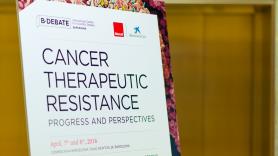2. Tumor evolution and genetic signatures
As a tumor cell divides, its daughter cells accumulate mutations that may differ from the original cell. In the end, this leads to a more or less heterogeneous conglomerate whose variability will establish how sensitive the cells are to treatment and even if they can resist it and reemerge after what initially appears to have been successful treatment.
In 2011, the group led by Elaine Mardis, professor of Genetics and Medicine at the Washington University School of Medicine, participated in the first full genetic sequencing of a case of leukemia over time. Their study proved which cells responded to treatment and which ones didn’t. Now their studies are even more ambitious. “For acute myeloid leukemia there are very few markers that indicate a patient’s prognosis, beyond whether or not they respond well to chemotherapy. Genomics can help improve that,” explained Mardis. This is why they have studied the genetic profile of tumors in more than 70 leukemia patients. What they’ve seen is that if after one month there are at least 5% of cells with specific mutations, the patient’s prognosis is much worse. This helps classify patients to know if they need new treatment before the tumor reappears.
The rise of genetic sequencing techniques and IT tools is gradually contributing large amounts of information on tumors. Cancer isn't one single disease, there are at least 200 different types and really there are as many tumors as there are patients. But some are more similar than others, thus the need to group them together because in theory each group should respond better to one treatment or another. One example of these analyses was done with colon cancer: the group led by Rodrigo Dienstmann, oncologist and director of the Oncology Data Science (ODysSey) Group at the Vall d’Hebron Institute of Oncology, has studied the large-scale genetics of more than 4,000 of these tumors and has established 4 different groups, with the specific characteristics of each one and a different prognosis after treatment.
Another way of grouping them is by looking for signatures of a few genes whose alterations determine their aggressiveness and, on occasion, their response to specific drugs. For colon cancer, several of these signatures are named after Ramón Salazar, head of Medical Oncology at the ICO.
But in some cases analyzing the tumor isn't enough, its microenvironment must also be studied, the tissue surrounding it and on which it sits. Eduard Batlle, coordinator of the Oncology Program at the Institute for Research in Biomedicine Barcelona, discussed this, saying that at least for colon cancer, “A tumor’s tendency to metastasize depends not so much on the cancer itself but more on the tissue on which it is found.” What they’ve seen is that most of the genes that predict a relapse are active at the microenvironment of the cancer, and that the vast majority are activated by a molecule called TGF-β. This is why scientists are working on drugs to inhibit it.
CANCER MODELS
In order to study new therapies, clinical trials are key. But before a drug can be tested on patients, it must be researched as much as possible in the laboratory.
One of the first ways of analyzing how a therapy works and behaves is to test it in cell lines, cultures on slides of immortalized tumor cells. But this is just the first step, far from the clinical reality.
In order to get a bit closer to the “real world”, scientists then use models called “xenografts”: fragments of tumors from patients that are put in lab mice. These models are widely used, for example, by the group led by Carlos Caldas, professor of Oncology at the University of Cambridge. Using large collections of these models, they’ve studied many characteristics of several tumors: their mutations, epigenetics, heterogeneity. And they’re also looking for new drugs and combinations that effectively target specific mutations.
One step further is what is known as Orthoxenografts, a model made from implanting a tumor fragment from a patient into the corresponding organ of the mouse, thus closely reproducing the biology. One of the top experts in this model is Alberto Villanueva, head of the ICO Chemoresistance group and co-founder of the spin-off Xenopat, which generates these models. By using them, scientists can not only research the effect different drugs have on specific tumors, they can also reproduce the clinical progress of a specific patient. Implanting a tumor fragment in a series of mice can allow scientists to test various treatments at the same time to identify the most effective option.



